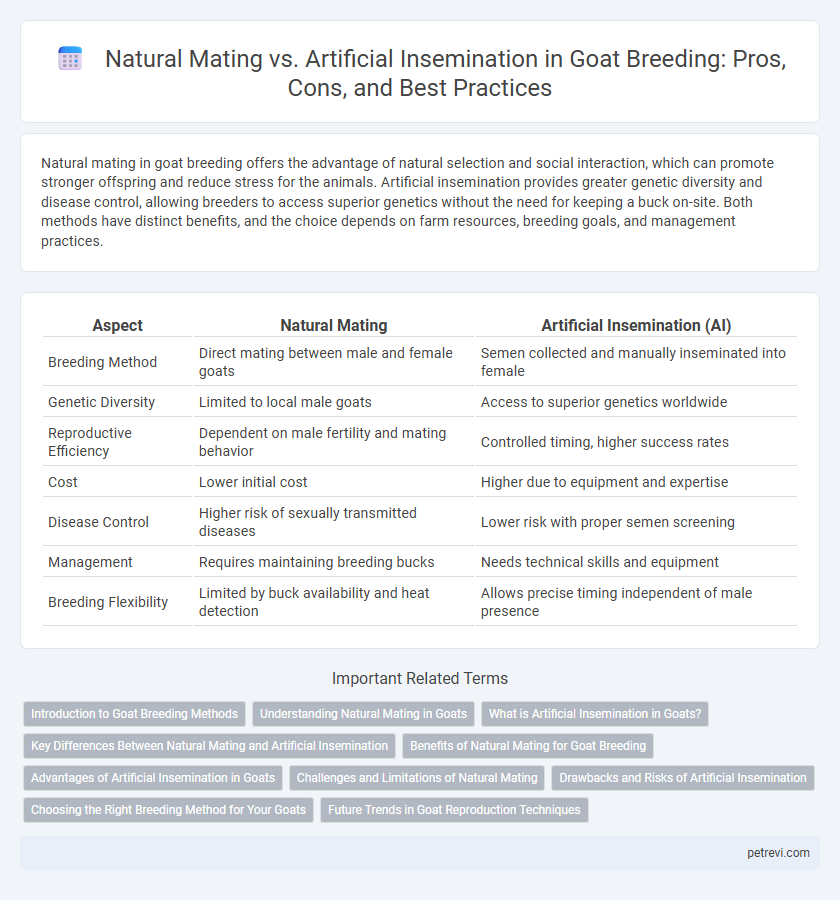Natural mating in goat breeding offers the advantage of natural selection and social interaction, which can promote stronger offspring and reduce stress for the animals. Artificial insemination provides greater genetic diversity and disease control, allowing breeders to access superior genetics without the need for keeping a buck on-site. Both methods have distinct benefits, and the choice depends on farm resources, breeding goals, and management practices.
Table of Comparison
| Aspect | Natural Mating | Artificial Insemination (AI) |
|---|---|---|
| Breeding Method | Direct mating between male and female goats | Semen collected and manually inseminated into female |
| Genetic Diversity | Limited to local male goats | Access to superior genetics worldwide |
| Reproductive Efficiency | Dependent on male fertility and mating behavior | Controlled timing, higher success rates |
| Cost | Lower initial cost | Higher due to equipment and expertise |
| Disease Control | Higher risk of sexually transmitted diseases | Lower risk with proper semen screening |
| Management | Requires maintaining breeding bucks | Needs technical skills and equipment |
| Breeding Flexibility | Limited by buck availability and heat detection | Allows precise timing independent of male presence |
Introduction to Goat Breeding Methods
Goat breeding methods primarily include natural mating and artificial insemination, each with distinct advantages for herd improvement. Natural mating involves direct contact between a buck and does, allowing natural selection and behavioral cues to guide reproduction, while artificial insemination enables controlled genetic advancement by introducing semen from superior sires without physical breeding. Understanding these methods is crucial for optimizing fertility rates, genetic diversity, and overall herd productivity in modern goat farming.
Understanding Natural Mating in Goats
Natural mating in goats involves direct interaction between buck and doe, ensuring natural selection and breeding behaviors that can enhance genetic diversity and adaptability. This method allows for natural pheromone signaling and heat detection, optimizing fertility and conception rates without the need for specialized equipment. Understanding natural mating helps breeders maintain traditional breeding practices while monitoring for hereditary traits and reproductive health.
What is Artificial Insemination in Goats?
Artificial insemination in goats involves the deliberate introduction of processed semen into the female reproductive tract without natural mating, enhancing genetic diversity and disease control. This technique requires semen collection from a selected buck, followed by proper handling, storage, and timed insemination to optimize conception rates. Farmers use artificial insemination to improve herd genetics, increase reproductive efficiency, and overcome physical breeding barriers.
Key Differences Between Natural Mating and Artificial Insemination
Natural mating in goats involves direct physical copulation, ensuring the transfer of fresh and viable sperm, but it carries risks such as disease transmission and limited genetic diversity. Artificial insemination (AI) allows controlled breeding using preserved semen from genetically superior bucks, enhancing genetic improvement and biosecurity while requiring specialized skills and equipment. The choice between these methods depends on factors like herd size, breeding goals, cost, and management capacity.
Benefits of Natural Mating for Goat Breeding
Natural mating in goat breeding promotes stronger genetic diversity by allowing natural selection to play a key role in mate choice. This method encourages natural behaviors, enhancing fertility rates and overall herd health without the need for specialized equipment or technical skills. Moreover, natural mating reduces the risk of transmission of diseases commonly associated with artificial insemination practices.
Advantages of Artificial Insemination in Goats
Artificial insemination in goats offers precise genetic control, enabling breeders to select superior traits and improve herd quality without transporting animals. This method reduces the risk of disease transmission compared to natural mating and allows for breeding programs regardless of geographical limitations. Additionally, artificial insemination enhances reproductive efficiency by enabling timed breeding cycles and optimizing semen use.
Challenges and Limitations of Natural Mating
Natural mating in goat breeding faces challenges such as limited genetic diversity and increased risk of sexually transmitted diseases. Physical injuries and stress on both bucks and does can reduce reproductive efficiency. Additionally, natural mating requires more labor and time, limiting scalability for large herds.
Drawbacks and Risks of Artificial Insemination
Artificial insemination in goats poses risks such as reduced genetic diversity and potential transmission of diseases through contaminated semen. The procedure requires specialized equipment and skilled technicians, increasing costs and limiting accessibility for small-scale farmers. Additionally, improper handling can lead to low conception rates and stress in does, negatively affecting overall reproductive success.
Choosing the Right Breeding Method for Your Goats
Natural mating in goats allows for natural selection and mate compatibility, ensuring strong offspring but requires more space and management to prevent disease transmission. Artificial insemination offers precise genetic control, reduces physical risk, and enables access to superior sires globally, though it demands technical skills and equipment. Selecting the optimal breeding method depends on herd goals, resources, and desired genetic improvements to enhance productivity and health.
Future Trends in Goat Reproduction Techniques
Natural mating in goat breeding ensures genetic diversity through direct sire selection, but artificial insemination (AI) offers precise control over genetic traits and disease prevention. Future trends emphasize integrating advanced reproductive technologies like genomic selection and cryopreservation to enhance breeding efficiency and sustainability. Innovations such as automated semen analysis and AI blockchain tracking systems are expected to revolutionize goat reproduction, improving herd management and productivity.
Natural Mating vs Artificial Insemination for Goat Breeding Infographic

 petrevi.com
petrevi.com